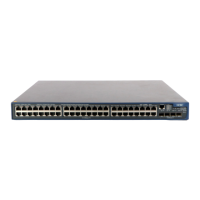1-6
Field Description
Exceed action
Action to take for exceeding packets:
z drop: Drops the packets.
z remark-dscp: Re-marks the DSCP precedence of the packets
and forwards the packets.
Priority action
Priority marking action, which can be:
z cos: Sets 802.1p precedence for packets.
z dscp: Sets DSCP precedence for packets.
z ip-precedence: Sets IP precedence for packets.
z local-precedence: Sets local precedence for packets.
Redirected to
z “interface” indicates that the packets are redirected to the port.
z “cpu” indicates that the packets are redirected to the CPU.
z “link-aggregation-group” indicates that the packets are redirected
to the aggregation group.
inprofile Statistics about the packets within the traffic limit
outprofile Statistics about the packets beyond the traffic limit
Mirrored to
z “monitor interface” indicates that the packets are duplicated to a
port.
z “cpu” indicates that the packets are duplicated to the CPU.
Queue scheduling mode
Queue scheduling algorithm, which can be:
z strict priority
z weighted round robin (WRR)
z weighted fair queuing (WFQ)
Remark vlan Target VLAN ID used in VLAN mapping
display qos-interface line-rate
Syntax
display qos-interface { interface-type interface-number | unit-id } line-rate
View
Any view
Parameters
interface-type interface-number: Specifies the type and number of the port, of which the line rate
configuration is to be displayed.
unit-id: Unit ID of the switch for which line rate configuration is to be displayed. For the value range for
the unit-id argument, refer to
Table 1-2.
Description
Use the display qos-interface line-rate command to display the line rate configuration of a port or the
ports on a unit.
Related commands: line-rate.
Examples
# Display the line rate configuration of Ethernet 1/0/1.

